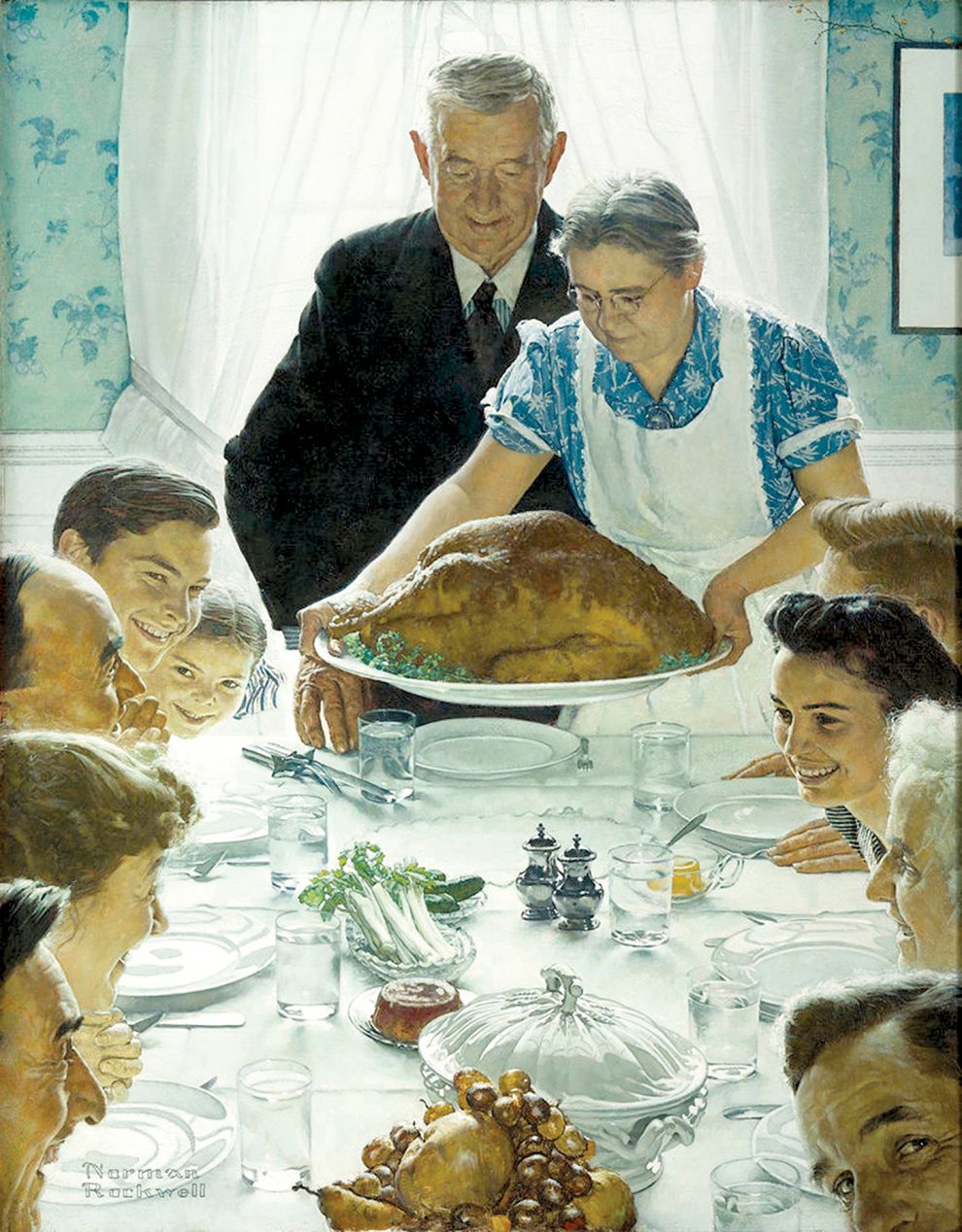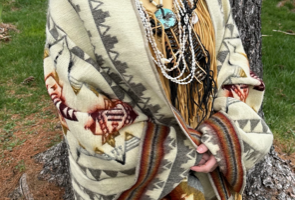By Yvonne Wright • The Current Contributing Writer
Our cook cooked it, I painted it, and we ate it.
That was one of the few times I’ve ever eaten the model.
— Norman Rockwell
One of the world’s oldest celebrations observable across the millennia and practiced by most civilizations, regardless of their cultural and social advancements, is the customary giving of thanks for the annual harvest. Climate dependent and ruled by capricious gods, whose favor and protection for graciously bestowing bountiful crops upon the land needed constant appeasing, was a celebration with spiritual and social context.
Early Thanksgiving rituals brought together families and tribes in a joyous appreciation of the land that fed them, giving thanks to nature, as well as local deities, for sustainability through toilsome work, followed by great feasting that lasted sometimes for days.
In the year 1621, with the arrival of settlers at Plymouth Rock, the modern American tradition of thanksgiving begins. “A Day of Thanksgiving” was formally declared as a national holiday by George Washington in 1789, to be celebrated on the last Thursday in November; however, some time later, Thomas Jefferson put an end to it, considering it a religious celebration rather than civic, and as such, contrary to the US Constitution which prohibited any connection between church and state.
The observance of Thanksgiving became a nationwide holiday once again under Abraham Lincoln (considered the modern father of Thanksgiving), who reinstated it in 1863. A year later, the first turkey was ceremonially pardoned, and adopted as a pet by Lincoln’s son Tad. In time, the November Thanksgiving Holiday evolved into what it is perceived of today, as a time to give thanks for the foundation of the nation, and not just as a celebration of the harvest – becoming one of the most significant holidays in the United States.
When thinking of Thanksgiving as that special day of the year traditionally marked by formal dinners and happy gatherings, often spent in ancestral homes to which scattered family members flock each year with great anticipation… one cannot help but recall the iconic painting by Norman Rockwell, “Thanksgiving Dinner“ (a.k.a “Freedom from Want”).
Painted in 1943 as a front cover for The Saturday Evening Post, it is today one of the best known paintings in American history and perhaps the most reproduced work by the artist.
In the course of four decades, Rockwell created over 320 covers for the magazine, which had a readership of 3 million at its height. Among them, there were four paintings in the series called “Four Freedoms,“ of which “Thanksgiving Dinner“ was a part, inspired by President Roosevelt’s 1941 compassionate speech about the preservation of democratic values: freedom of speech, freedom of worship, freedom from want, and freedom from fear, in the face of grave danger from Nazi Germany.
The popularity of these four works was immense, and when the original paintings toured across America in 1943, almost $133 million dollars in war-bonds were collected from the exhibition ticket and poster sales. To all, “Thanksgiving Dinner” signified traditional middle class values with heart-warming nostalgia for simpler and better times, particularly longed for during the economical hardship and danger brought upon by the Second World War then raging in Europe and in Asia–Pacific.
With thousands of American soldiers away from home and actively engaged in the war, Rockwell’s visual simplicity in portraying a nucleus family of several generations (using neighbors and his wife as models) gathered around the table for Thanksgiving dinner, was a depiction of an American ideal of homeliness and abundance without extravagance, understood and cherished by the public. It emphasized (along with the three other works from the series) “the capacity of people to free themselves from all kinds of want – physical, emotional, and even spiritual.”
The “Four Freedoms“ paintings reproduced subsequently each week on the front cover of The Saturday Evening Post magazine turned Norman Rockwell into a national celebrity. His masterful ability to depict people going about their lives, enjoying simple pleasures and expressing a variety of emotions, captivated the public. His honest and humorous ‘characters’ conveyed that “sensitive feeling for humanity” as the Post’s art editor, Kenneth Stuart, once wrote.
While the art critic for WNYC Public Radio, Deborah Solomon, described Rockwell’s use of white dinner plates sitting on a white tablecloth as “one of the most ambitious plays of white-against-white since James Whistler’s Symphony in White, No. 1.”
The New York Times compared Rockwell’s works to Mark Twain’s novels, asserting the artist as “probably the best-loved U.S. artist alive.” While, German political satirist George Grosz praised the artist for his “excellent technique, great strength, and clearness of touch that the old masters had.” Reproduced continuously on magazine covers in the 1930s, ’40s, and ’50s, Rockwell’s paintings delivered a delicate balance of optimism and sharp social commentary stemming from his fondness for small-town life.
As the tide of new social realities changed the way contemporary art was looked at and perceived, some of the art critics in the 1960s and ‘70s dismissed Rockwell’s style for a lack of artistic merit – especially, when a leading champion of Abstract Expressionism, Clement Greenberg, wrote particularly harsh words about Rockwell’s idealized representations, calling them too sentimental, saccharine and commercial.
“You have to put Rockwell down, down below the rank of minor artist,” insisted Greenberg, the father of categorizing art in terms of “high” versus “low” artistic worthiness, and whose writings influenced generations of art criticism in the second half of the 20th-century, with a strong prejudice against classically figurative depictions.
Yet, Rockwell’s ideology for creating paintings was simple: “maybe, I grew up and found the world wasn’t the perfect place I had thought it to be, I unconsciously decided that if it wasn’t an ideal world, it should be, and so painted only the ideal aspects of it,” confessed the artist.
Fast forwarding to the 21st century, there has been resurgent interest in Rockwell’s art, as if re-discovered and appreciated anew for the contributions he made to American popular culture. Categorized within the Regionalism art movement and American scene painting style, Rockwell’s ability to enter the American psyche helped him to address many controversial, contemporary issues, often overlooked by his critics.
In his later years, being a skilled pictorial storyteller, the artist advocated for the civil rights movement, and used his playful in nature compositions to hint at shifting gender roles, class divides, democratic values, and acceptance of all races and religions. “His work has helped define how to convey a message that may not be broadly palatable, or may have something controversial in it, in a way that gets people to look and think” explained Barbara Tannenbaum, curator at the Cleveland Museum, who instigated a survey of Rockwell’s work for the Akron Museum of Art in 2007.
Born in New York City in 1894, Norman Rockwell’s ancestry included an English painter Howard Hill (known for meticulously detailed genre paintings and depictions of animals), who brought his family over to America in 1858. Rockwell’s mother, Mary Ann “Nancy” Hill, learned how to paint from her father and passed that love of painting down to her son.
Rockwell’s father also encouraged his son’s early interest in drawing, even after the artist quit high school for good to devote himself completely to art, by sending his son first to the National Academy of Design and later to the Art Students League in New York City. The artist spent most of his adult life in Stockbridge, Massachusetts, where he passed at the age of 84, in 1978. Today, the majority of Rockwell’s works can be found at the New York Historical Society and the Norman Rockwell Museum in Stockbridge, Massachusetts.
As we celebrate this year’s Thanksgiving holiday, let us remember the enduring legacy of Rockwell’s art, whose relevance still touches our hearts and makes us see more vividly all the blessings and freedoms we enjoy and experience in America.
Yvonne Wright is the owner of STUDIO YNW at 100 West Broadway in Jim Thorpe. She can be reached at studio.ynw@gmail.com



























Add Comment